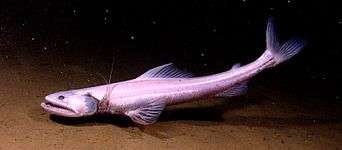Deepsea lizardfish
| Deepsea lizardfish | |
|---|---|
 | |
| Scientific classification | |
| Kingdom: | Animalia |
| Phylum: | Chordata |
| Class: | Actinopterygii |
| Order: | Aulopiformes |
| Family: | Bathysauridae |
| Genus: | Bathysaurus |
| Species: | B. ferox |
| Binomial name | |
| Bathysaurus ferox Günther, 1878 | |
The deepsea lizardfish, Bathysaurus ferox, is an aulopiform of the family Bathysauridae, found in tropical and subtropical seas across the world. The deepsea lizardfish should not be confused with the true or "typical" lizardfishes of the related family Synodontidae.
Taxonomy
Deepsea lizardfishes were first described in 1878 by British zoologist Albert Günther who created the generic name from ancient Greek word elements “báthos” and “saûros” meaning “lizard of the depths”. Previously recognized in the synodontidae, Johnson et al. 1996 showed its relationships outside Synodontidae in its own family in the suborder Giganturoidei.[1]
At the beginning of the century, Bathysaurs ferox larvae were thought to be a distinct species called Macristium chavesi. Robert Johnson, professor of Biology at the University of Charleston gave evidence to the synonymy of the two species.[2]
Appearance

.jpg)
Deep-sea lizardfish resemble shallow-water lizardfishes, as reflected in their common names. Adults reach over 70 cm in length and have a slender and cylindrical body. Their lizard-like bony head is very depressed and an enormous mouth is filled with multiple series of long, sharp and needle like teeth for piercing and trapping prey. Bathysaurus ferox are whitish, grey or brown and are covered in tough scales, enlarged along the lateral line. The large, well developed eyes with large pupils are evidence of the importance of vision for prey detection. Although residual sunlight does not penetrate the depths inhabited by deep-sea lizardfish, their eyes aid in detecting distinct sources of residual or bioluminescent light.[3] Deep-sea lizardfish have been known to have an expansive liver constituting up to 20% of total weight serving as an energy reserve to sustain growth between sporadic feeding episodes.[4]
Habitat
Deepsea lizardfish are characteristical inhabitants of the ocean floor. They are found circumglobal in tropical and temperate latitudes (65° N to 40° S) at depths of 600 - 3,500 m, in the aphotic zone were water temperatures range between 4 and 3 °C.[5]
The energy poor ecosystem dictates low population densities. Along the Mid Atlantic Bight a numerical density of 0-8 fish/ 25 x 103 m2 has been reported.[4]
Feeding habits

Deepsea lizardfish are one of the world's deepest living apex predators, and will not hesitate to eat anything they meet, including their own kind. They are predominantly piscivors hunting demersal and bathypelagic fishes. Occasionally they also feed on crustacea and molluscs, as well as dead fish drifting down from above.
Most of the time deepsea lizardfish maintain a motionless stance on the substrate with head and fore-body raised, waiting for prey.[6] Being well equipped to pursue and devour whole prey, it can capture it by lunging forward in a sudden rapid burst accompanied with a snap of their trap-like jaws.[4]
Fisheries
Although being common inhabitants of the ocean floor, deep-sea fishes are considered a conservation concern.[6]
Reproduction
Deepsea lizardfish are hermaphrodites, which means they bear both male and female sex organs, thought to be an adaptation to low population densities. Mature gonads found in samples from November to January off the coast of Virginia show that their reproduction is synchronous in means of maximizing breeding population densities without increasing size of the feeding population. The mean fecundity rates around 32000 ova per fish were observed for eight specimens. Not much is known about their mating habits, however larval deepsea lizardfish have been recorded at the surface of the ocean.[4]
References
- ↑ Nelson, J. S. (2006). Fishes of the World (4 ed.). Hoboken, NJ: John Wiley & Sons. p. 222. ISBN 978-0-471-25031-9.
- ↑ Johnson, Robert Karl (1974). "A Macristium larva from the Gulf of Mexico with additional evidence for the synonymy of Macristium with Bathysaurus (Myctophiformes: Bathysauridae)". Copeia. 1974 (4): 973–977. doi:10.2307/1442599.
- ↑ Davis, Matthew P.; Fielitz, Christopher (2010). "Estimating divergence times of lizardfishes and their allies (Euteleostei: Aulopiformes) and the timing of deep-sea adaptations". Molecular Phylogenetics and Evolution. 57 (3): 1194–1208. doi:10.1016/j.ympev.2010.09.003.
- 1 2 3 4 Sulak, Kenneth J.; Wenner, Charles A.; Sedberry, George R.; Guelpen, Louis Van (1985). "The life history and systematics of deep-sea lizard fishes, genus Bathysaurus (Synodontidae)". Canadian Journal of Zoology. 63 (3): 623–642. doi:10.1139/z85-091.
- ↑ Sulak (1990). Check-list of the fishes of the eastern tropical Atlantic.
- 1 2 Baker, Krista D.; Haedrich, Richard L.; Snelgrove, Paul V.R.; Wareham, Vonda E.; Edinger, Evan N.; Gilkinson, Kent D. (2012). "Small-scale patterns of deep-sea fish distributions and assemblages of the Grand Banks, Newfoundland continental slope". Deep-Sea Research Part I: Oceanographic Research Papers. 65: 171–188. doi:10.1016/j.dsr.2012.03.012.
- Froese, Rainer and Pauly, Daniel, eds. (2006). "Bathysaurus ferox" in FishBase. May 2006 version.
- Tony Ayling & Geoffrey Cox, Collins Guide to the Sea Fishes of New Zealand, (William Collins Publishers Ltd, Auckland, New Zealand 1982) ISBN 0-00-216987-8